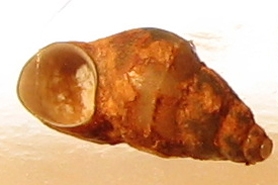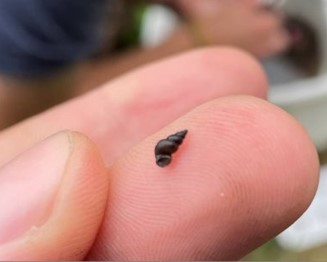New Zealand mudsnail
(Potamopyrgus antipodarum)
The New Zealand mudsnail is a small snail native to New Zealand, and it is considered naturalized in Australia and Europe. They were first discovered in the Snake River in Idaho in 1987. It is believed they hitchhiked with imported live gamefish and/or on recreational wading gear from invaded waters. Since its discovery, the New Zealand mudsnail has spread throughout the western U.S. and the Great Lakes region.
Classification in Wisconsin: Prohibited
Ecological Threat
The New Zealand mudsnail has a wide range of environmental tolerances and has been found in nearly every freshwater habitat. They are primary consumers and nocturnal grazers, feeding on sediments and algae. They have an operculum, or a trapdoor, that allows them to resist desiccation and most cleaning agents. Outside of their native range, they have not been observed to reproduce sexually and are all clonal; they can give birth up to ~90 juveniles at once, or ~230/year. In their native range, they are known to reproduce both sexually and asexually.
Effects
Research on the effects of New Zealand mudsnails on Wisconsin streams is currently ongoing and provides some evidence that overall density of macroinvertebrates, particularly mayflies and amphipods, is negatively correlated with mudsnail biomass and density. Research from Wisconsin streams suggests that some fish (brown trout, brook trout, rainbow trout, and mottled sculpin) will readily eat them. However, energetic studies show that New Zealand mudsnails can pass through fish stomachs undigested and therefore may offer little to no energy when compared to other common food items. Currently, there is little evidence to suggest that mudsnails are leading to reductions in growth rates of the brown trout that consume them in southern Wisconsin; however, it is unclear what impacts they may have in less productive systems or over the long term. New Zealand mudsnails do have predators in their native range, but there is no evidence that predators do or could control populations outside their native range.
Spread
Due to their small size, the New Zealand mudsnail can easily hitchhike on a variety of recreational and commercial equipment that comes into contact with the water. The operculum allows it and its developing juveniles to survive out of water and in other undesirable environments for extended periods. Initial invasion pathways to the United States are thought to have been through ballast water or in the water of live game fish shipped from invaded waters. Many other pathways may contribute to the secondary spread of New Zealand mudsnails. These pathways include but are not limited to waders and other fishing gear, watercraft, commercial construction equipment and fish stocking equipment.
Identification
The New Zealand mudsnail has an elongated dextral (right-handed coiling) shell with slightly thickened, outturning aperture (opening) with 7 to 8 whorls (twirls) separated by deep grooves. The thin operculum has an inconspicuous off-center nucleus with spirals radiating outward. The shell color can range from gray to light or dark brown. In the Great Lakes, the New Zealand mudsnail typically measures 4 to 6 mm in length but grows to 12 mm regularly in its native range.
There are different morphs or clones present in North America. Clones from the Great Lakes generally exhibit a keel with spines in the middle of each whorl. All the New Zealand mudsnails observed in Wisconsin inland waters lack the keel and exhibit features of the western morph.
Common native look-alike species include other small snails, such as: Amnicola limosa, Fluminicoa sp., Lymnaedae sp., Physidae sp. Non-native look-alike species include faucet snails (Bithynia tentaculata).
Distribution
See the reported locations of New Zealand mudsnails in Wisconsin.
Do you know of other populations? Please send us a report.
Control
Mechanical: There are no effective mechanical methods that would also not be a potential risk to non-target species.
Chemical: There is no effective chemical that would also not be a potential risk to non-target species.
Prevention: The best way to keep a waterbody free of New Zealand mudsnails is to prevent their establishment. However, hand removal may not be enough to remove New Zealand mudsnails due to their small size. Several effective methods to prevent their spread have been identified.
The following guidelines work for both boating and wading equipment:
- BEFORE leaving the water:
- INSPECT equipment and REMOVE attached plants and animals (required by law).
- DRAIN all water from equipment (required by law).
- SCRUB equipment with a stiff brush, including crevices.
- RINSE equipment with tap water. Consider keeping a water jug or spray bottle in your car.
- BEFORE entering another stream, switch to a completely new set of gear OR do one of the following disinfection steps:
- SPRAY with hot water (>122 degrees Fahrenheit) for at least 15 seconds.
- SOAK with Formula 409 for 10 minutes.
- FREEZE for 2 hours.
- WASH with 212-degree Fahrenheit water (steam clean).
- SOAK in 2% Virkon solution (2.7 ounces per gallon) for 20 minutes.
Additional recommendations
- Avoid using felt-soled boots. They are more likely to harbor small, invasive species and are very difficult to decontaminate.
- Consider having a second pair of waders or boots if it may not be practical to clean your waders when moving between waters.
- If visiting multiple sites along the length of a stream or river, begin at the top of the watershed and work your way downstream.
- BEFORE leaving the water:
Resources
Sources for content




